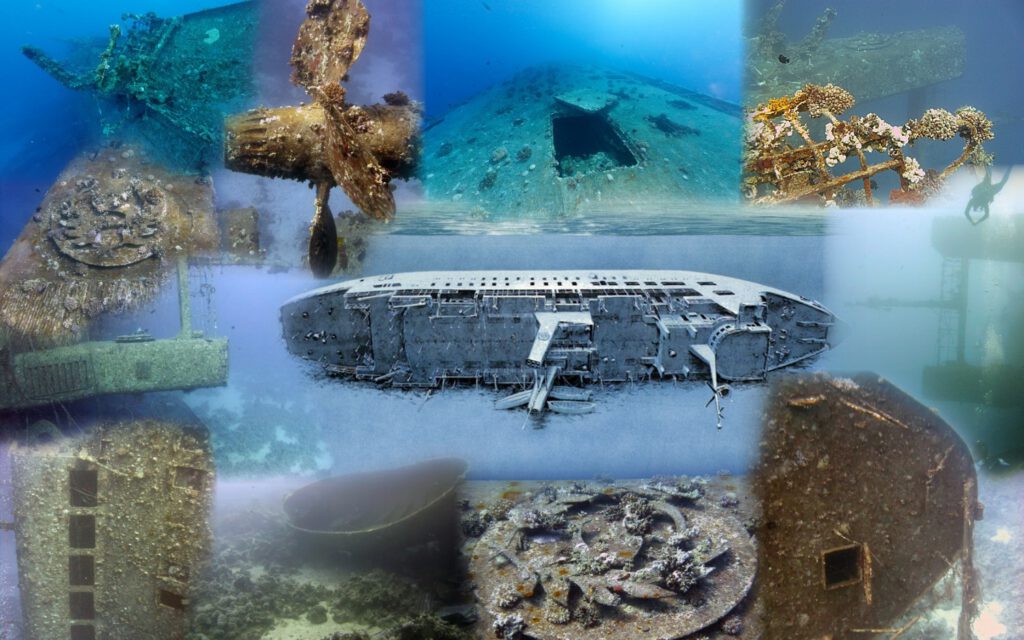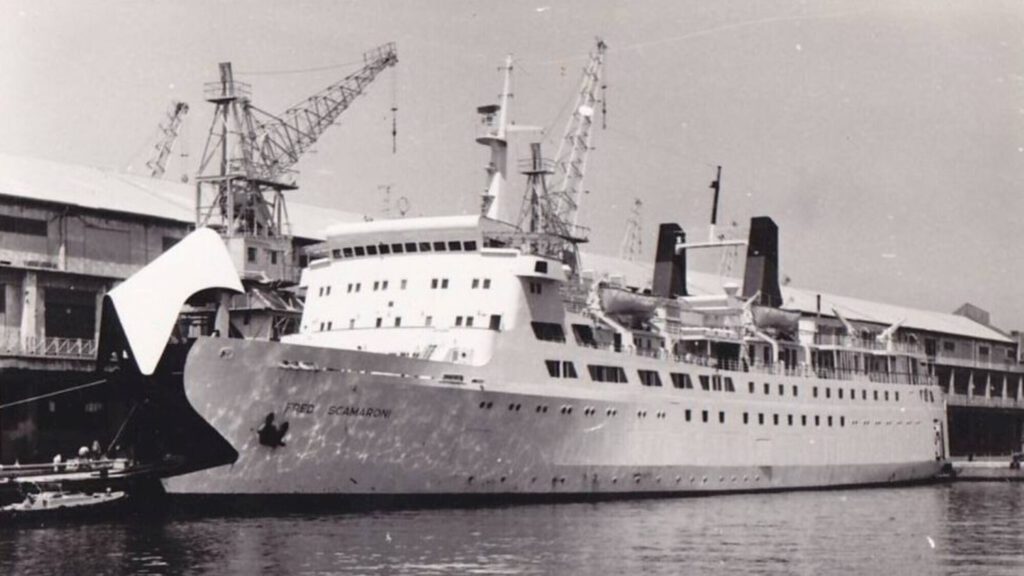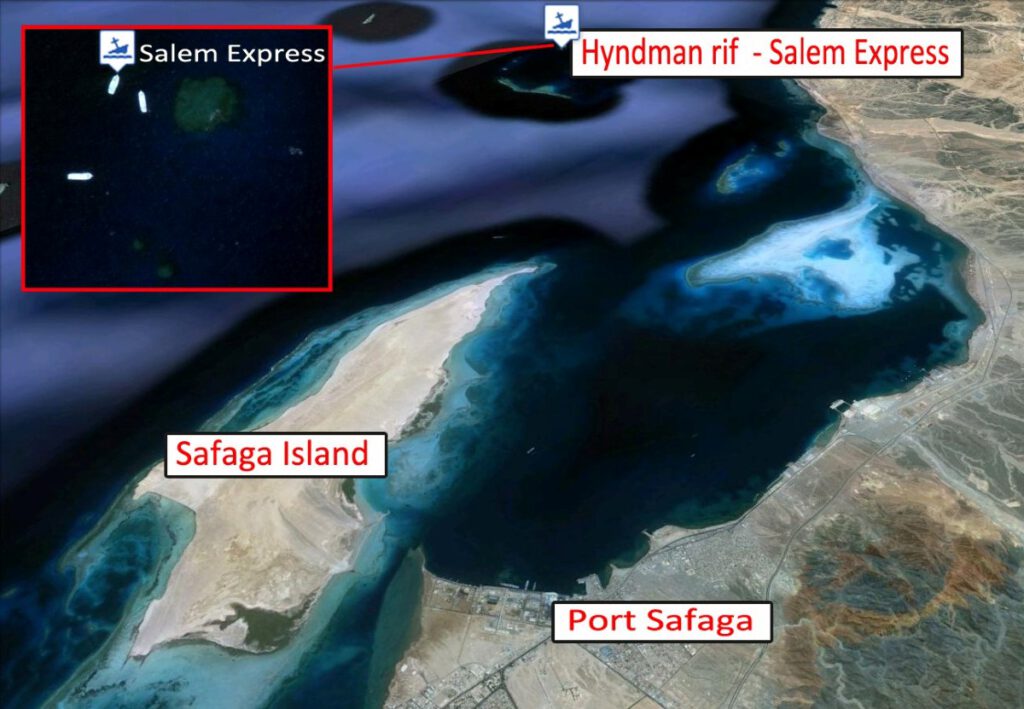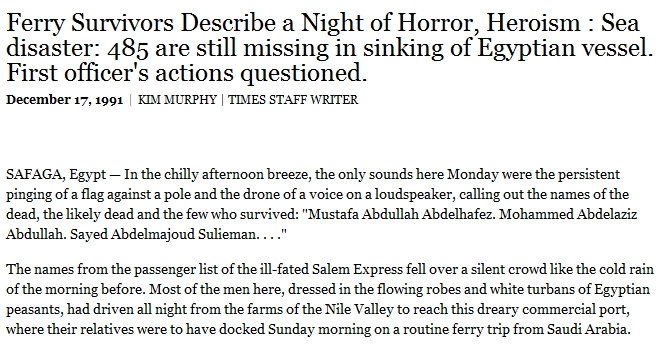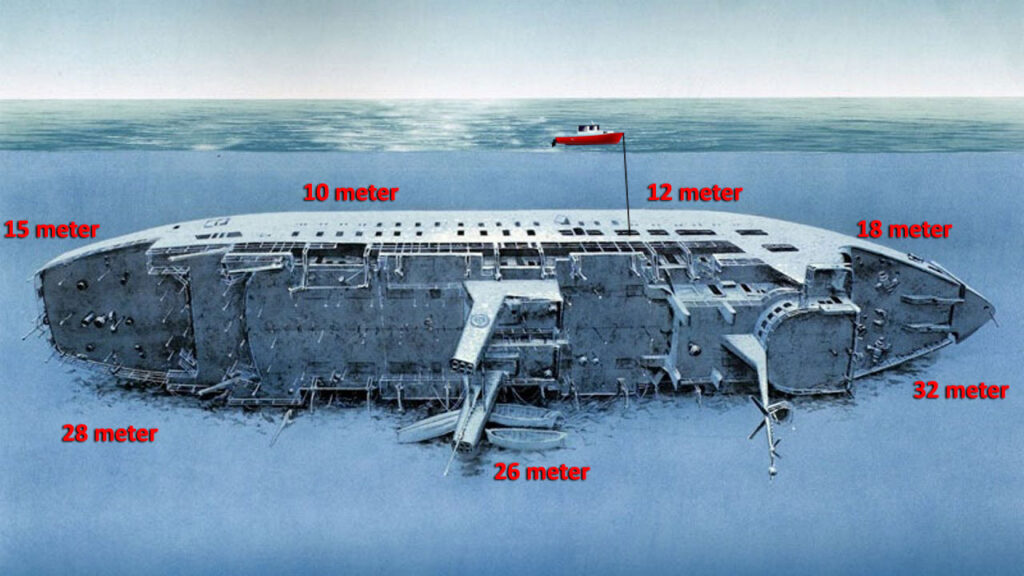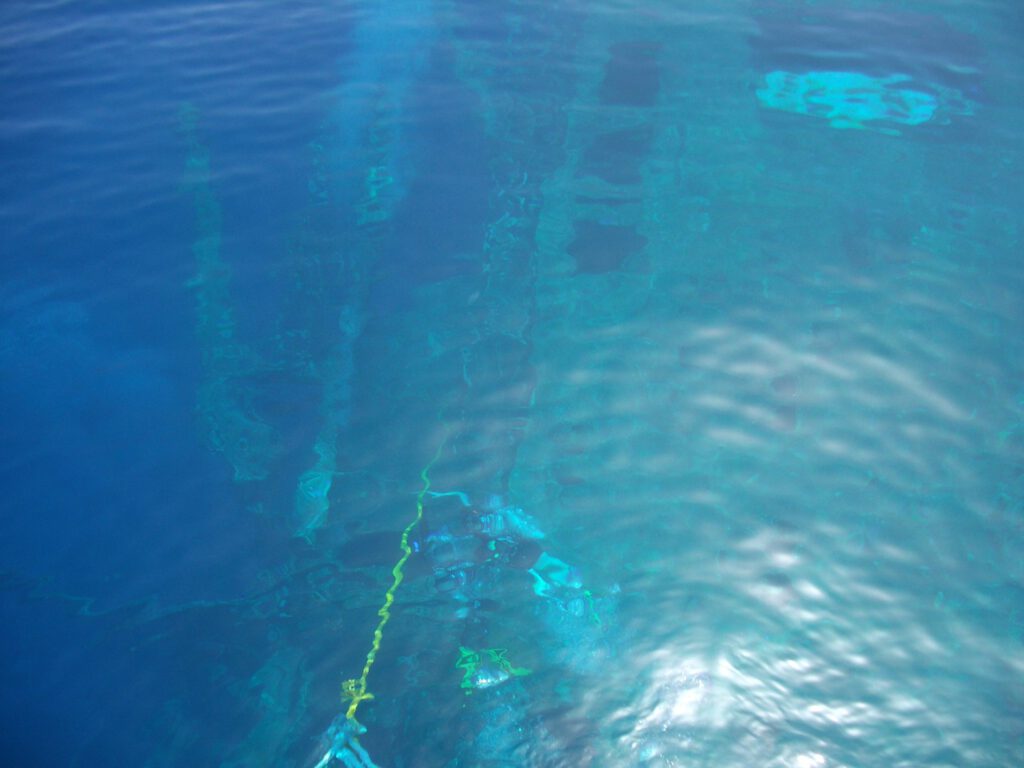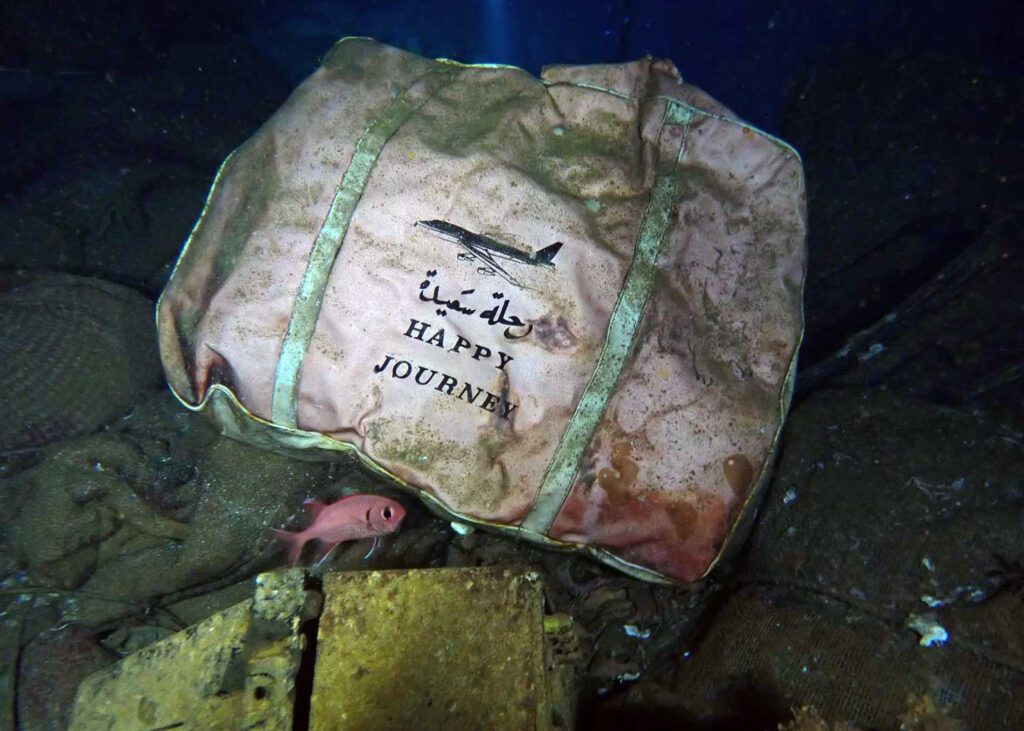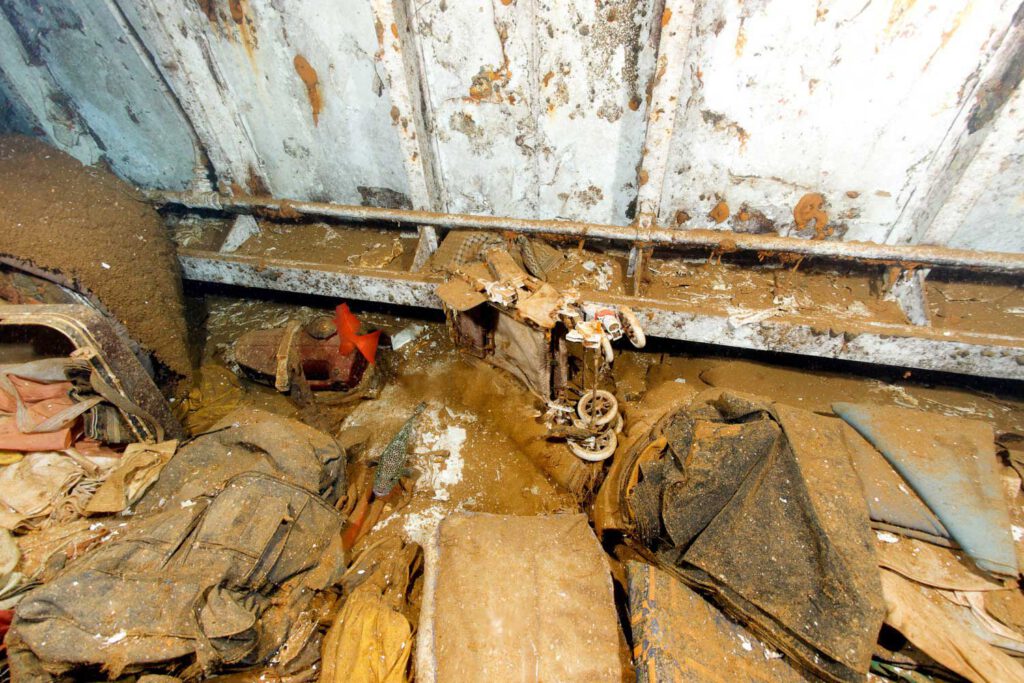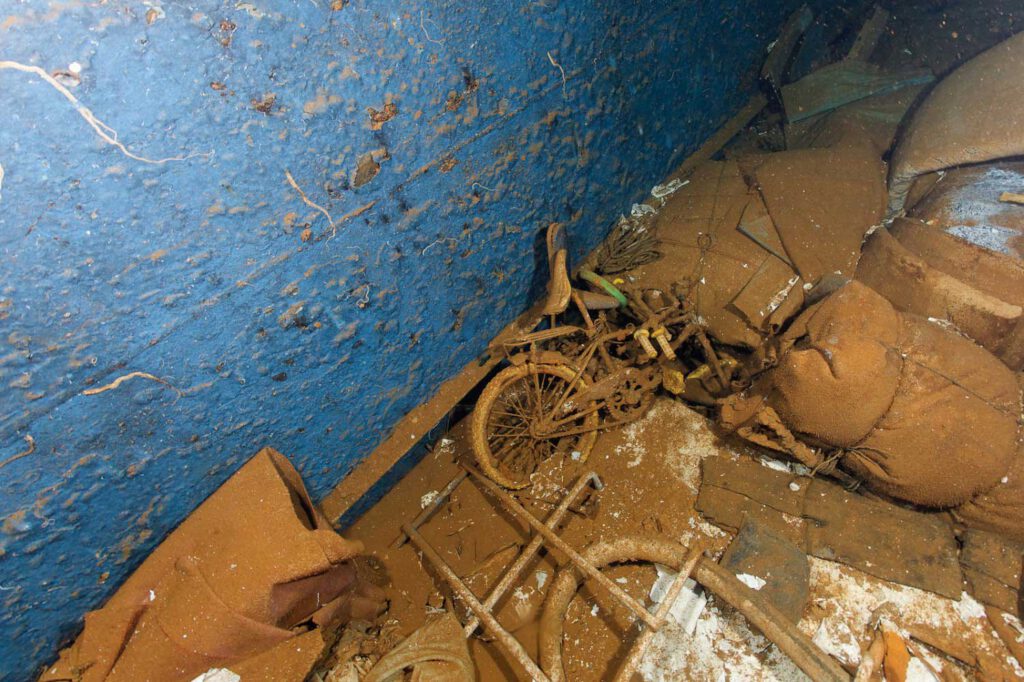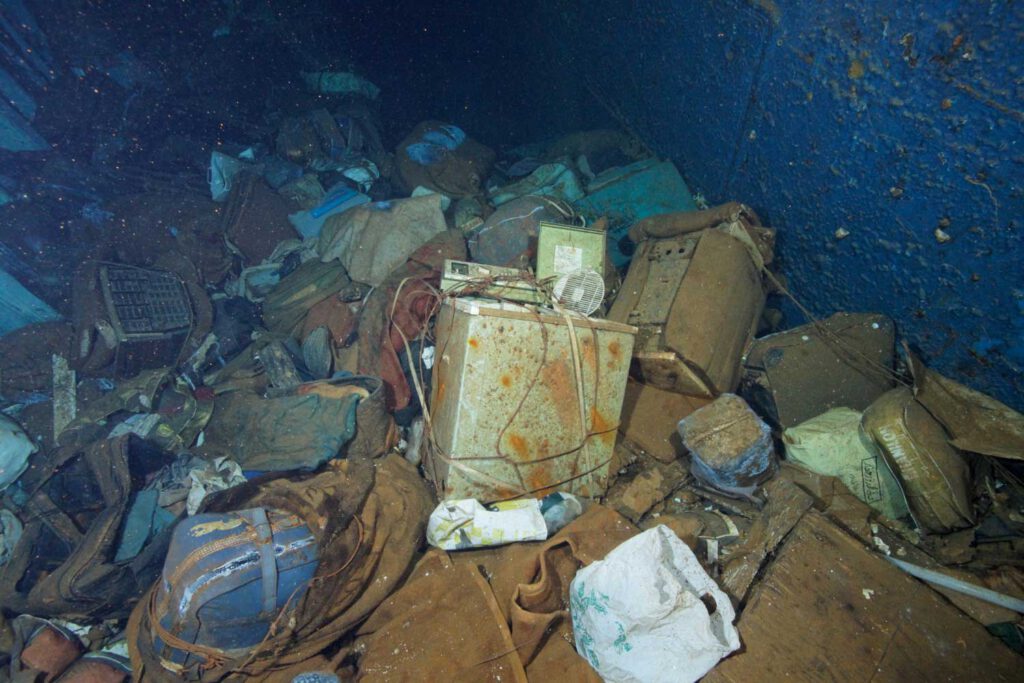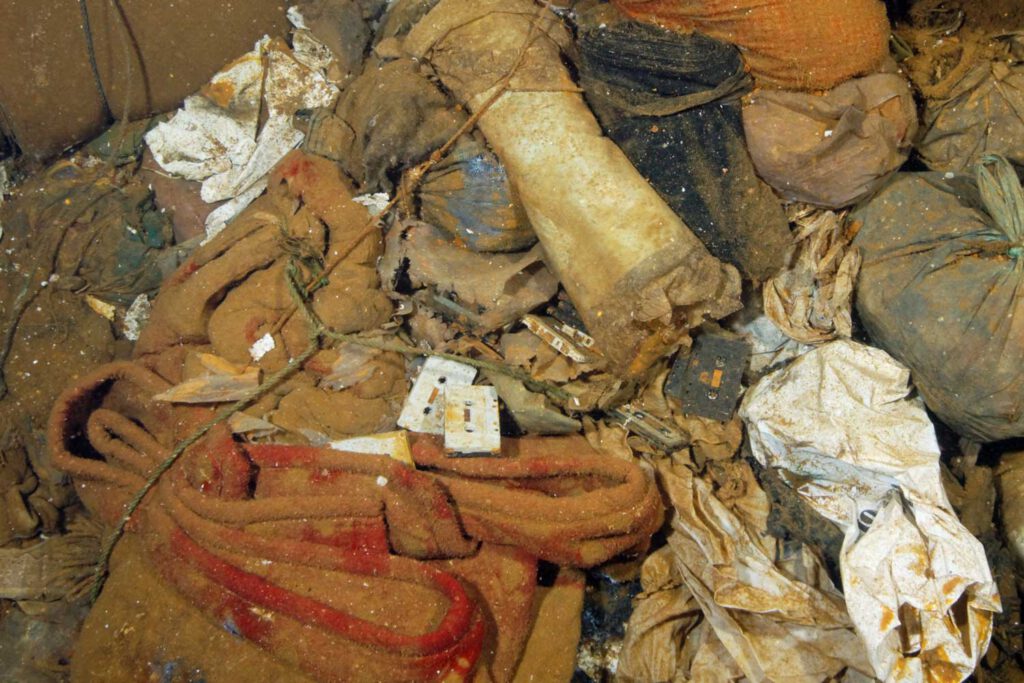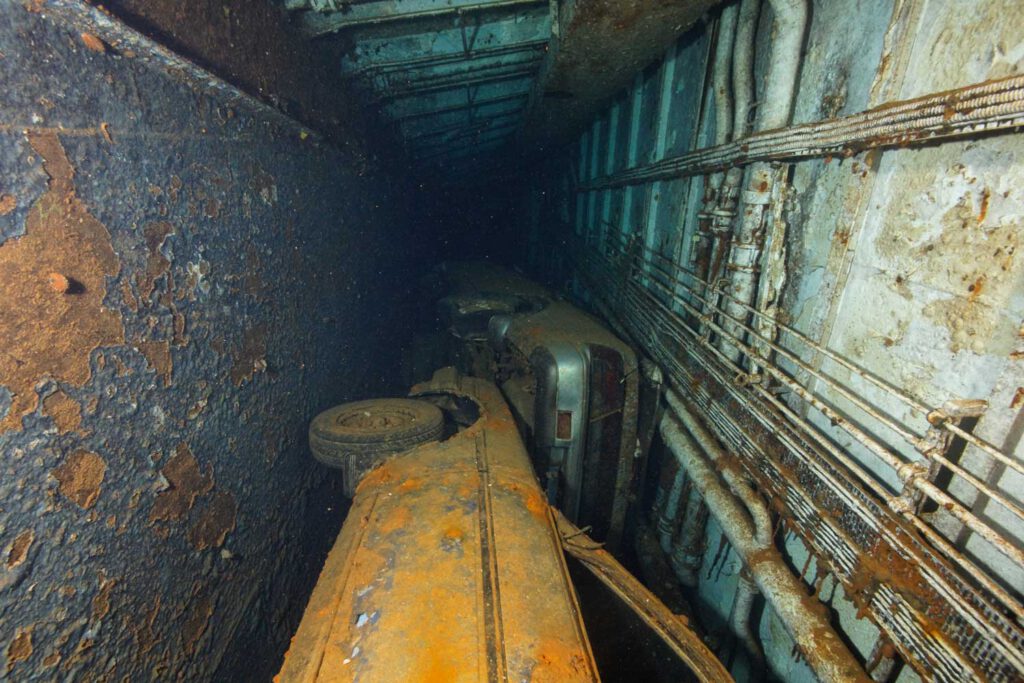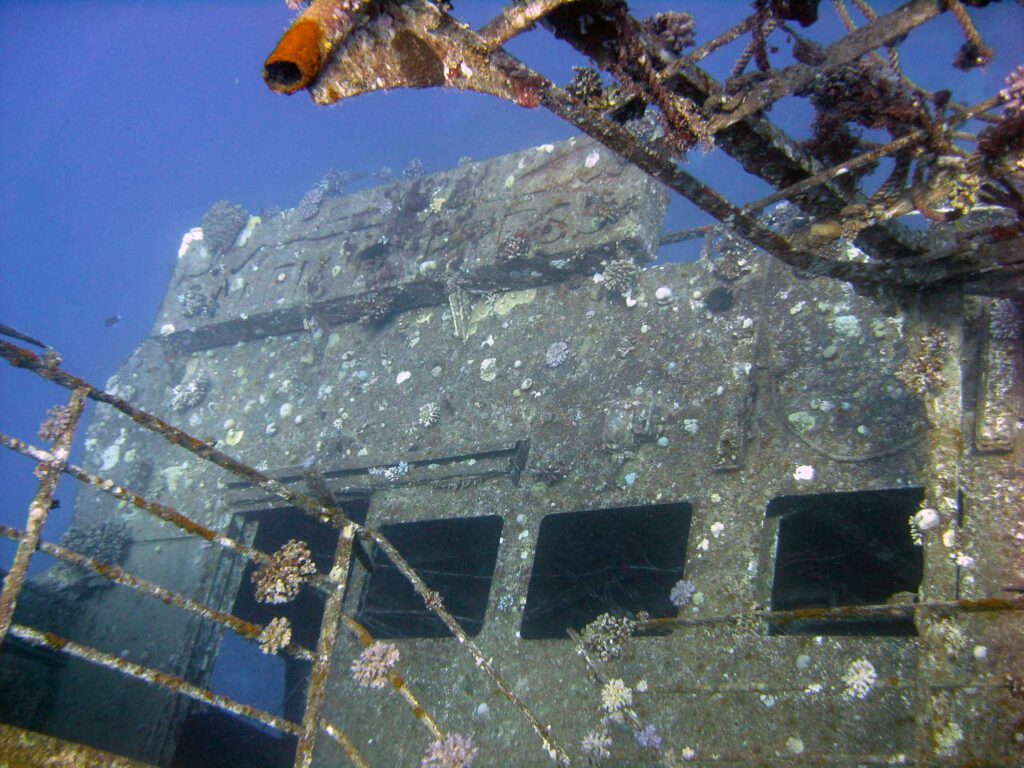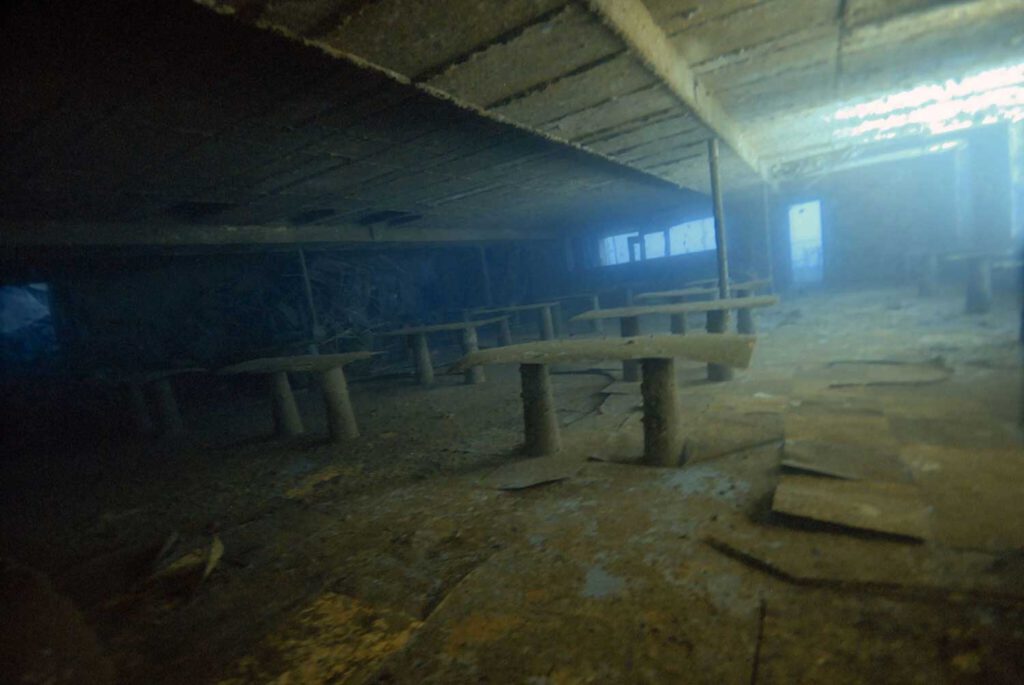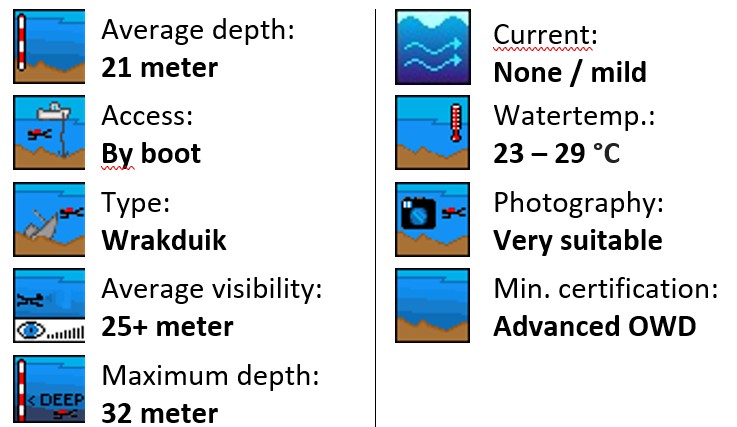Salem Express - Safaga - Egypt
Owing to the tragic loss of lives in the incident there is much controversy as to whether the wreck should be open to scuba divers or not. The ship itself is resting at a depth of 12 to 30 meters.
This famous wreck in the Red Sea is a maritime grave and it is a very emotional dive. It requires utmost respect to visit this sad site of tragedy.

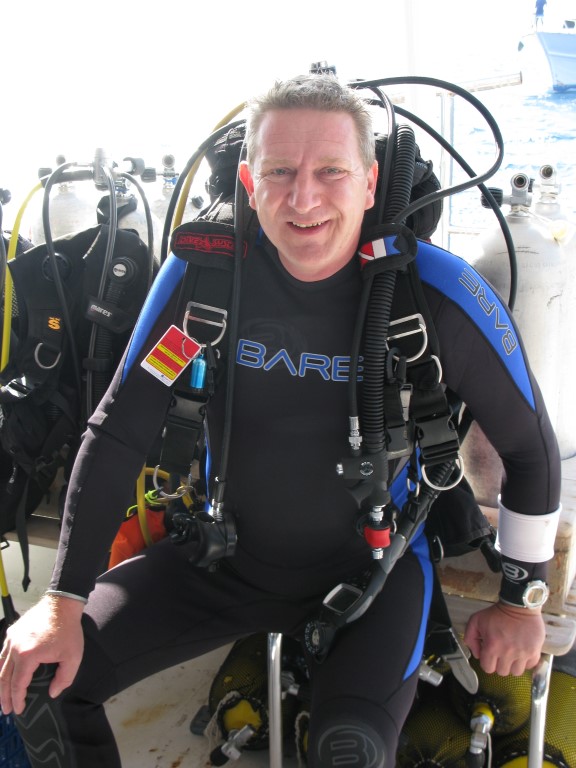
NOTE: At this time the PDF of the published article is only available in Dutch.
Sorry for the inconvenience.
Click to view the original article as PDF (Dutch)
The Salem Express (Safaga - Egypt)
This time we discuss the “Salem Express”, (Fred Scamaroni ) christened during its launch.
Bought by the Egyptian government, the ship ensured the connection between Port Jeddah (Saudi Arabia) and Port Safaga (Egypt).
The ship met a very tragic end that will remain etched in the memories of hundreds of Egyptian families for a long time.
We dived this wreck togheter only once in 2008 during our divemaster course.
NOTE: We make use of “Sketchfab” click HERE to view the navigation controls
Click on the 3D model below to move it around
All credits to the below Photogrammetry models goes out to Holger Buss
Specific Photogrammetry areas of the Salem Express
Click on the ‘play’ button to activate the animation.
When active press’f’ key for fullscreen. (Press ‘Esc’ key to return)
Luggage in the Salem Express
Cars in the wreck of the Salem Express
The story & the dive
The data
- Type : Passenger boat / Ferry
- Tonnage: 4771 tons
- Year of construction: 1976
- Length: 100.29 meters
- Width: 18.1 meters
- Date of sinking: December 15, 1991
- Minimum depth of wreck: 10 meters
- Maximum depth to seabed: approx. 32 metres
- Current location: 26° 39′ 01″ N, 34° 03′ 48″E
Hyndman Reef, Southeast of Safaga, Egypt
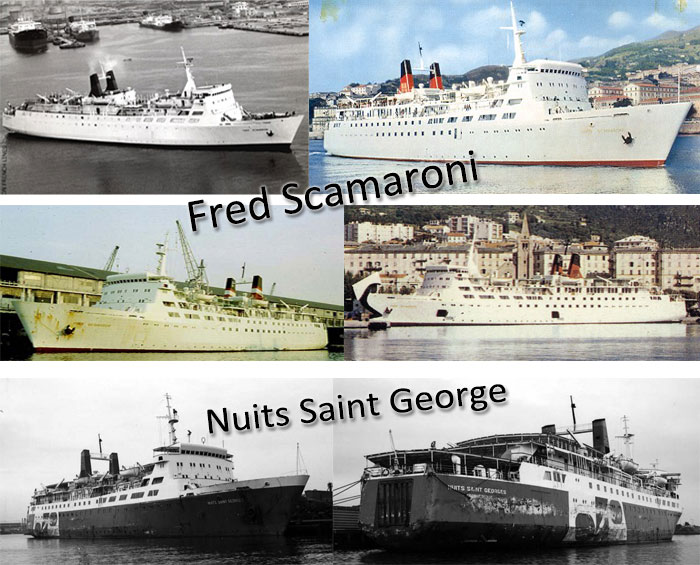
The ‘Salem Express’ under the names:
“Fred Scamaroni” and “Nuits Saint George”
The ship
launched in 1964 under the name “Fred Scamaroni ” in La Seyne by the French shipbuilder ” Constructions” Navales et Industrielles de la Mediterranee “.
The ship could accommodate 1384 persons and 142 vehicles. There were 428 cabins on board for passenger accommodation. She had an unladen draft of 4.92 metres and was powered by a 4 x 8 cylinder diesel engine with 2 screws built by ” Ch de L’Atlantique ” from La Seyne . This gave her a power of 14,880 hp. The ship had already suffered damage before, on 17 May 1966 the ship was sailing on the Marseille route France – Ajaccio (a municipality of Corsica), and collided with the quay wall in Ajaccio on 20 January 1967. The result; minor damage to both ship and quay. The ship continued to serve between Marseille and Corsica. On 23 April 1970 a fire broke out on board while she was en route to Bastia (another municipality of Corsica) this was brought under control and extinguished by the ship’s crew.
Repairs to the ship took her about 2 weeks, after which she was able to resume normal service.
On 31 January 1980, the ship was sold for US$4 million to the Danish shipping company of Ole Lauritzen , Ribe, Denmark, and renamed the ” Nuits Saint George “. The ship was put into service on the Ramsgate – Dunkirk ferry route on 15 May 1980.
However, this route proved unsuccessful and the ferry service ended the following September.
The ship ran aground on 29 August 1980 at Ramsgate and was subsequently moved to our own Vlissingen on 4 September 1980 when the Ole Lauritzen shipping company went bankrupt .
In November 1980, the Nuits Saint George was sold to the Egyptian shipping company “Lord Maritime Enterprise” and renamed “Lord Sinai” to provide service on the Aqaba-Suez route until 1984.
After that, the ship was renamed Al Tahra , and continued to serve the same route until it was sold to the “Samatour” Shipping Company, Suez, Egypt” in 1988, which was owned by Hussein Salem.
Here the ship got its last name; “Salem Express”

Hussein Salem
The story
The Salem Express is a typical example of a wreck that captures the imagination because of its dramatic sinking. The Egyptian ferry was on its way from the Saudi port of Jeddah to Safaga during the stormy night of December 16, 1991, with on board mostly Egyptian pilgrims who had just visited their holy city of Mecca.
The owner of the ship was Hussein Salem, a well-known Egyptian tycoon. He was a former intelligence officer and a close friend of then-president Mubarak. It was the first Egyptian ferry to sink in the Red Sea and the first accident of its kind in the history of Egypt.
The captain was the very experienced, Egyptian Navy graduate Hassan Moro who knew the area so well that he was one of the few who dared to sail between the dangerous Hyndman reef and the mainland. Almost all other ships sailed around it with a wide arc, which often took them 2 hours longer.
This route was also officially not allowed after sunset. However, on the evening in question the weather was so bad that the ship somehow got off course and ended up with a heavy blow on the southernmost point of the Hyndman reef.
The impact of the collision caused the large loading and unloading door of the bow to come loose, so that the water entered the ship very quickly. The ship had sunk within 20 minutes. It all happened so quickly that the crew did not have a chance to lower the lifeboats. Several small ships anchored behind the large reef were unable to provide quick assistance to the sinking Salem, as they were afraid of getting into trouble themselves.
According to a testimony from one of the skippers, he could see the lights of the Salem Express disappearing from his view. The tragedy did not end there, unfortunately, due to a power outage it was no longer possible to open the electrically operated doors and many passengers were trapped without any chance of escape.
Because the ship had too many passengers on board, many were forced to go on deck, this was also their salvation for many. Fortunately, many drowning people who were in the water were helped by the current that pushed them towards land.
Despite this, only 180 passengers managed to reach land by swimming, partly due to the fact that many Egyptians could not swim. At the time of the disaster, a Dutchman was also working on the Salem, he gave a full statement to the investigators which is fully documented in the official report.
He was convinced that the captain was not to blame for the disaster.
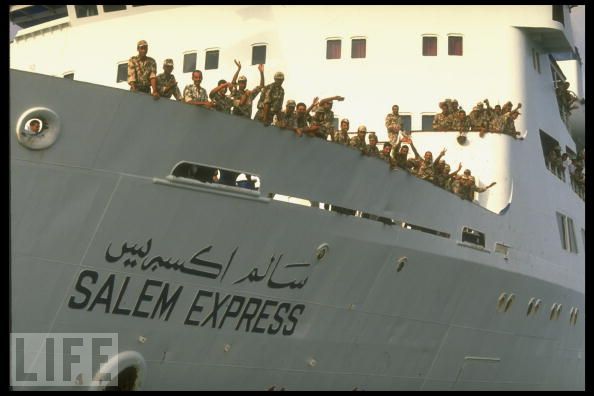
Salem Express was also working as a troop ship during the 1991 Gulf war.
Below are some quotes from the report:
Willem van K. surviving pilot from the Salem express disaster. From the testimony to the investigator; Hurghada December 24 1991:
“I am Willem van K., the son of Marcus and Saskia van K. from Amsterdam.
I am quite an experienced seaman, I should say, and thank God, it was not the first wreck I’ve been witnessing. Therefore, it will not be hard to provide a sober professional view on the event. I have everything written down in this notebook – I specially keep it for occasions like this. Yes, no doubt the vessel was overloaded, almost twice. I do not believe that it is the captain’s fault. Hassan Moro was an impeccable sailor and his death on duty proves it.
The survivors had to swim for their lives, although – as you might know, the Arabs have never been taught how to swim. The sinking was so swift that none of the lifeboats or rafts had been launched. The people were on their own.
The following passage from the report also showed that the relationship with the detective was, to put it mildly, not optimal:
What? Oh, please, be a grown man! Here it comes: Black Pilot… Should you also remember the Flying Dutchman to me?
We, pilots, unlike you, superstitious Pinkertons, know how to rely on facts. Let the straightforwardness of the old ship sea dog not offend you, young man: i’ve heard enough of your fables in my lifetime. Do you happen to have any other questions – not related to mythology?
Then – see you later!”
But the final official report stated that the Salem Express was lost due to human error; that of the captain.
But Captain Moro also went down with his ship that fateful evening. It is still incomprehensible to many that owner Hussein Salem was never convicted for this tragedy, but with friends like Zakaria Azmi (former Chief of Presidential Staff) and then President Hosni Mubarak , apparently that is not a problem in Egypt.
Currently he is even the exporter of Egyptian Natural Gas to Israel…
A tragedy that officially cost the lives of at least 470 passengers.
Official figures ( Lloyd’s casualty report):
649 persons on board, including 71 crew and 578 passengers. 180 survivors. (117 bodies have been recovered of the estimated 464 victims)
Unofficial figures:
Number of passengers probably more than 1500
About 1300 passengers did not survive the disaster!
Divers report having recovered approximately 450 bodies from the wreck in the first few days.
The salvage
The salvage operation got underway after just 2 days.
In 1991 there was only 1 diving center in Safaga with 2 diving instructors and a navy rescue team of 12 people. In short there were a total of 14 divers available for the total salvage. The next day more volunteer divers from Hurghada and Sharm el Sheikh came to Safaga to help, bringing the total number of divers to 32. They had minimal information, the only information that was given was that the ship with all its passengers had gone down due to bad weather. In the next 3 days the divers would experience their worst nightmare…..
The divers were divided into several groups and formed a kind of chain, in this way the bodies of the drowned passengers who were in the upper cabins of the ship were passed up where they were pulled onto the boat with the help of ropes.
According to the divers, they recovered about 450 bodies in the first few days of the recovery.
Based on the testimonies of various divers, it was such a terrible experience that several divers have never been underwater again. The recovered bodies were already in a state of decomposition, but the large pressure difference during the recovery caused them to suffer even more damage.
Contrary to the official death toll, it is estimated that more than 1,300 people did not survive the disaster.
Because it became too risky for the divers to also retrieve the bodies of the passengers from the deeper spaces, it was decided after a few days to stop the recovery of the victims and welders from the Egyptian Navy were called in to seal the ship for further access.
That also answers the question of whether there are still bodies in the ship?…..
Yes, deep within the ship there are still countless bodies…
The loss of the Salem Express led to a review of the ‘short-cut’ route used by Hassan Moro , and the longer route was made mandatory for all large ships.
The diving or not?
Diving this wreck does raise some contradictions. Some divers refuse to dive this ship and even have problems with divers who do. They believe that diving the Salem Express should be prohibited and of course they are entitled to this opinion. It is not for me to say who is right and who is wrong.
As a passionate wreck diver I would under no circumstances want to glorify diving this wreck.
But the fact remains that we divers are allowed to dive on this ship without any conditions.
Personally I find it strange that divers who refuse to dive the Salem Express dive without any qualms of conscience on wrecks such as the Carnatic where 31 people lost their lives and for example the Thistlegorm where the death toll was 9.
I think that everyone should decide for themselves whether they want to dive on these kinds of wrecks or not, and regardless of your opinion, you should not hold others accountable for this.
In any case, my attitude is respectful given the circumstances.
The ship is listed as a grave monument, so treat it as such during your dive.
P.S. Also consider the feelings of the Egyptian crew on board of your diving boat, Egyptians have different ideas than for example Europeans. An exuberant story about your dive in the presence of the crew is generally not appreciated.
Many crew members have also lost loved ones during this disaster.
Also keep in mind that some crew members/dive guides will not be joining a Salem Express trip.
The dive
The ship lies on its starboard side at a maximum depth of approximately 32 meters, port side at approximately 12 meters depth close to the reef. This sea tragedy where an estimated 800 people lost their lives during a stormy night has now, many years later, become a home for marine life and is visited daily by divers from all over the world.
Everywhere on and around the ship are still personal belongings; bags, shoes and electronic equipment. The lifeboats that are still hanging in the davits (and now also on the bottom next to the wreck) prove the speed with which this accident happened.
The first divers who arrived at the wreck spoke of a ‘comet tail’ behind the ship. They meant the trail that the ship had made across the bottom. This shows that the ship still had a lot of speed when it was already underwater and running on the bottom.
From the boat you can actualy see the ship, because the side of the ship is only around 10 meters below the surface.
For years it was forbidden to dive on this wreck, but it was still done illegally, because Safaga was far away and before a boat could sail out the divers were long gone again.
Slowly but surely, the coral is starting to attach itself to the 100-meter-long wreck. Be careful when entering the holds or living quarters, as there have been several accidents because divers become completely disoriented in the interior of this ship lying on its starboard side.
The dilemma
There are 2 places where you can enter the ship, but I will not mention them here. Personaly I entered the ship once, this because I was invited by a Czech expedition making a documentary. But to be honest, I would NOT recommend to penetrate this ship as a recreational diver!
Because the ship is on its side, you are immediately disoriented, the walls change into the ceiling or the floor. Inside the ship it is literally full of luggage, from suitcases to loose clothing, from bicycles to radios and TVs.
There are also dozens of (freight) cars in rows on the car deck.
At that moment you have to suppress your feelings and not dwell too long on the thought of what happened here on that fateful evening of December 15th.
And that is very difficult, I can tell you.
My personal limit was reached when I was rather deep into he ship and saw a stroller with a bag on it with the inscription “Happy journey”. (It turned out afterwards that there are a lot of these kinds of bags, they were handed out to the passengers)
At that moment something snapped and I only thought of one thing; I want to get out of here!
Fortunately I was able to keep myself under control because I still had to get out of the ship which took me 15 minutes.
After this experience I have decided that I will still dive on the Salem Express but that I will never enter this wreck again…
For a dive around the ship, it is best to go over the side of the ship to the bow. First, visit the wheelhouse, which is accessible if necessary. Behind the wheelhouse is the restaurant. Look around you carefully, because it is full of sea needles. For those who want to do this, the restaurant and the bridge are very easy to enter.
Continue your way towards the bow, just below the anchor, which is still in place, the damage the ship sustained when it hit the reef is still clearly visible. A large crack in the bow is the result. You are now at a depth of around 18 metres.
Then continue around the bow and descend here towards the seabed, note that it is around 32 metres deep there. From this point you can clearly see the wheelhouse and the entire size of the ship.
Now swim back towards the back of the ship and dive under the wheelhouse.
The bottom here is littered with corrugated iron and other rubbish. Behind the wheelhouse under the funnels are 2 lifeboats on the seabed, you will probably come across a large school of yellow coatfish against.
Click on the images below to enlarge
Next to the ship you can also see personal belongings of the passengers; a few radios, a pram and various suitcases are the silent witnesses of the tragedy that took place here.
After diving under the wheelhouse and looking at the lifeboats it is wise to take off a bit because of your deco times.
Take a look at the funnels here, these are provided with the logo of the ship, a large ‘S’.
Continue the dive to the stern where a large stern door now lies on the bottom, through which you can see a part of the car deck. The depth here is about 22 meters.
Next, go around the back of the ship, which is actually the bottom of the ship, to look at the propellers.
The lower screw is at about 23 meters depth, the upper one at about 15 meters.
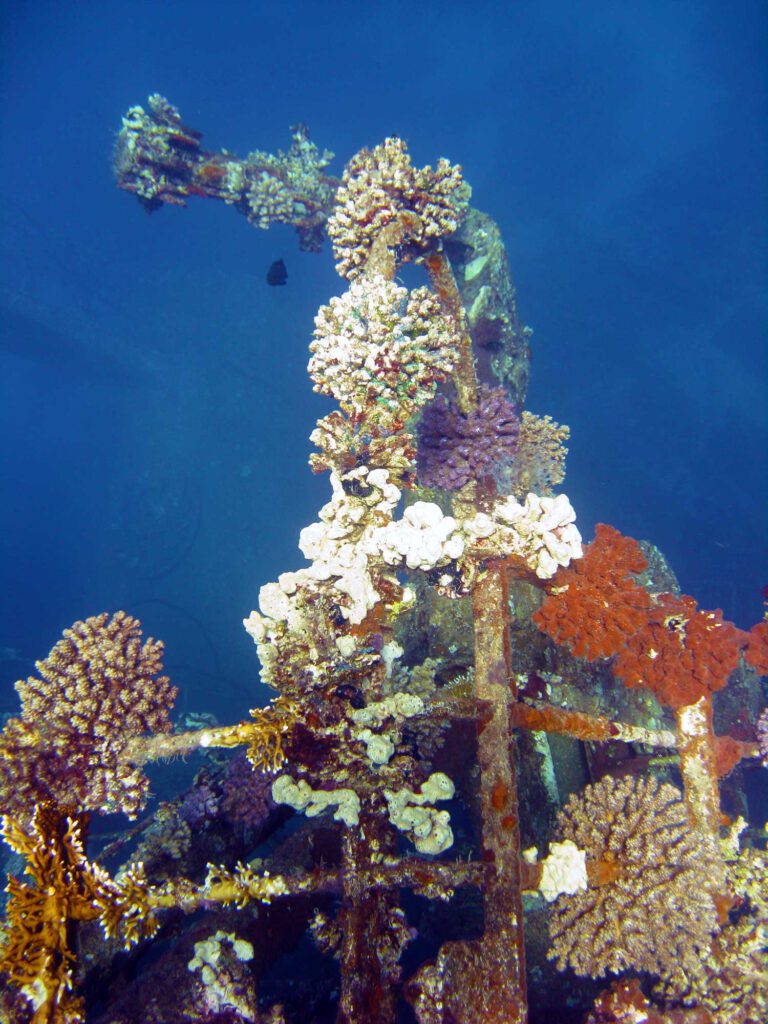
(Click to enlarge)
Continue to ascend until you are back on top of the wreck.
If you still have enough air left, it is worth spending some time here. It is full of beautiful corals and fish. The railing and even the cables and ropes that hang there are beautifully overgrown.
You can also find crocodile fish here, lying quietly on the deck. There are many puffer fish, clown fish and parrot fish, and on the walls you can even find nudibranchs.
Please take a moment to look around here.
You will be amazed at how much flora and fauna has managed to establish itself in such a short time.
End your dive by returning to the surface via one of the ropes.
Conclusion
Well, that was it….The salem Express
Gruesome? Yeah, I think so.
But still, I wanted to share this information with you.
Wrecks are simply the remains of a ship that has crashed, and the fact that this does not always have a ‘happy ending’ is evident from the story of the Salem Express.
Who hasn’t seen it, the movie ‘Titanic’, a beautiful, romantic movie… You would almost forget that there were also more than 1500 victims to mourn here.
Diving on the ship has been officially permitted since 1995, the wreck is open to divers although parts of the ship are inaccessible. Penetrating the ship is very dangerous and is therefore strongly discouraged.
The ship is officially registered as a grave monument.
Please, treat the ship with respect during your dive!
Again, you can do with this information what you will, and if you ever get the chance to dive this wreck, this information may be the deciding factor in your decision….
